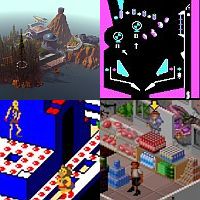By popular demand, the Game Developers Conference (GDC) is bringing back the Classic Games Postmortem series for the third consecutive year with sessions taking a close look at four seminal games at GDC 2013.
Organizers have revealed that postmortems for Crystal Castles, Myst, Pinball Construction Set and X-COM: UFO Defense are confirmed for this year's conference. Organized by the UBM Tech Game Network, GDC 2013 will take place March 25-29 at the Moscone Convention Center in San Francisco, California.
The Classic Game Postmortems series provides GDC attendees with sessions that examine the development of some of the industry's most influential landmark titles. The series debuted at GDC 2011 as part of the conference's twenty-fifth anniversary celebration, has featured games including Pac-Man, DOOM, and Maniac Mansion, and has returned each year since due to its ever-increasing popularity.
This year, the original designer and programmer of Crystal Castles, Franz Lanzinger, will discuss secrets of the classic Atari arcade game; Robyn Miller, co-director of Myst, the best-selling PC game of the 1990s, will share how he and his brother created a game that remains relevant more than 20 years later.
In addition, Bill Budge, father of the seminal Pinball Construction Set will lay out one of the earliest examples of an in-game editor - a title that game developer legend Will Wright has credited as a key influence on the simulation games that launched him to stardom; and Julian Gollop will reveal tactics he deployed in directing, co-designing, co-programming and co-drawing X-COM: UFO Defense. Additional details for each postmortem are as follows:
- Celebrating its 30th anniversary this year and notable for being the first arcade action game with an actual ending, Crystal Castles broke ground as a fast paced yet nonviolent 3D isometric game. The title was Atari's first arcade game with an ingenious secret warp system and impressed designers regardless of not using a traditional "attract" mode. Franz Lanzinger, the original programmer and designer, will share rare documents, sketches, photos, video and actual 6502 code with GDC attendees during his Classic Game Postmortem.
- Described as being an immersive experience that draws in players and doesn't let them go, Myst is the best-selling PC game of the 1990s and is also often attributed as the game that sold CD-ROM drives since its majestic 3D world was too large for floppy disks. Developed by Cyan and filled with puzzles and mysteries that unraveled in front of players' eyes, Myst could be argued as a title that began the notation of "experiencing" a game and not simply "playing" a game.
Since its release in 1993, Myst has been remade and ported to more than 10 platforms, including most recently the Nintendo 3DS and iOS. In his postmortem, Robyn Miller, the original co-creator and sound composer, will discuss the road to making a game that is still relevant to the game community two decades later.
- Published in 1983 by Electronic Arts, Pinball Construction Set created a new genre in video games that encouraged user generated content where players could trade personalized content via floppy disk. The game's editor allowed players to construct their own virtual pinball tables, and players could save these tables to disk and trade them with friends.
The editor's clean and simple interface even served as inspiration to designs behind SimCity six years later - The Sims creator Will Wright cited Pinball Construction Set as his key inspiration while speaking on the GDC 2012 panel "Forgotten Tales Remembered." Bill Budge, the father of the seminal Construction Set entry, will lay out the blueprints for how he created his own game and one of the earliest examples of an in-game editor.
- Finally, Firaxis' and 2K Games' recent X-COM: Enemy Unknown is actually a remake of a series that began twenty years ago. It all started in 1994 with MicroProse's UFO: Enemy Unknown, entitled X-COM: UFO Defense in North America, a real-time base management simulation with turn-based tactical combat and an engaging story of alien invasion.
The marriage of its distinct Geoscape and Battlescape views represented the game's strategy and battle modes, respectively; and they provided what felt like two different and compelling games in one. In this postmortem, Julian Gollop will lay out the tactics he deployed in directing, co-designing, co-programming, and even co-drawing the first, and often highest regarded, UFO/X-COM entry.
"Needless to say, we're very excited about this year's Classic Game Postmortem series line-up. The four titles are so diverse and each one helped shape new game genres that are still popular today," said Meggan Scavio, GDC general manager. "It's always fascinating to see original design documents from influential titles resurfaced and to hear from the creators of iconic titles that we grew up with pass on their knowledge to the next generation of game developers."
For more information about the 2013 Game Developers Conference or to register online, visit the official website.



